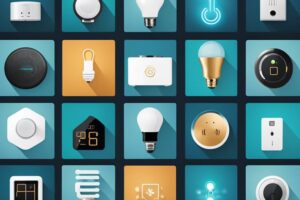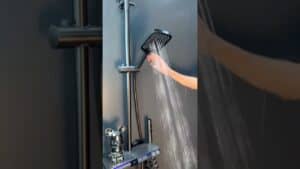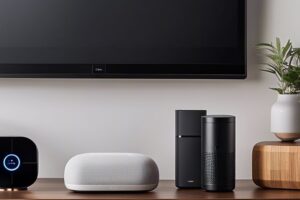Welcome to our comprehensive guide on how to control your smart home devices from anywhere in the world. With the rapid advancement in technology, it has become increasingly convenient to manage your home remotely using your smartphone or tablet. In this post, we will cover the essential steps and tips to help maximize the convenience and comfort of your smart home while ensuring the security of your devices.
Key Takeaways:
- Convenience – Remote control of smart home devices offers the convenience of managing them from anywhere, adding flexibility to your lifestyle.
- Security – Being able to control your devices remotely gives an added layer of security, allowing you to monitor and adjust settings even when you’re not at home.
- Energy Efficiency – Remote control allows for better management of energy usage, helping to reduce utility bills and environmental impact.
- Integration – Smart home systems often allow for the integration of various devices, creating a cohesive and interconnected living space that can be easily managed remotely.
- Customisation – Remote control enables the customisation of settings and preferences, giving you the power to adapt your living environment to your specific needs and preferences.
Preparing Your Smart Home for Remote Access
Before you can begin controlling your smart home devices remotely, you need to ensure that your home is properly set up for remote access. Implementing the following steps will help you to achieve just that.
Factors to Consider Before Setup
When preparing your smart home for remote access, there are several factors you need to take into consideration. Firstly, you need to ensure that your home network is secure and stable, as this is the foundation for all of your smart devices. Secondly, make sure that your smart home devices are compatible with remote access. It’s also important to consider the reliability of the devices and the security measures they offer. Furthermore, evaluate the bandwidth and data usage requirements, as some smart devices can consume a significant amount of data. Finally, assess whether you have the necessary technical expertise to set up and manage remote access for your smart home. This will ensure a smooth and successful implementation of remote control capabilities for your smart devices.
This will help you set up a secure and stable foundation for remote access, ensuring that your smart home is ready for you to manage from anywhere.
Choosing the Right Smart Home Ecosystem
When it comes to remote access, choosing the right smart home ecosystem is crucial. You need to select a system that offers compatibility with a wide range of devices and provides a user-friendly interface for remote control. Additionally, consider the scalability of the ecosystem, as you may want to expand your smart home network in the future. It is also essential to evaluate the customer support and security features offered by the smart home ecosystem. By choosing the right ecosystem, you can ensure a seamless and secure remote access experience for your smart home devices.
This will enable you to manage your smart devices remotely with ease, providing you with a convenient and efficient smart home experience.“`
How to Set Up Remote Control for Your Smart Home Devices
Setting up remote control for your smart home devices allows you to manage your home from anywhere, providing convenience and peace of mind. Whether you’re at work, on holiday, or simply in another room, remote access ensures that you’re always in control of your home environment.
Installing and Configuring a Central Hub
To enable remote control of your smart home devices, you need a central hub that connects all your devices and allows them to communicate with each other. This hub can be a smart home system from a single manufacturer, or a universal hub that supports multiple brands. Once you have your hub, follow the manufacturer’s instructions to set it up and connect it to your home network. Most hubs have user-friendly interfaces, guiding you through the process of adding and configuring your devices.
Tips for Secure Remote Access
When accessing your smart home devices remotely, it’s crucial to prioritise security to protect your privacy and home. Make sure to set strong, unique passwords for all your smart devices and the central hub, and enable two-factor authentication if available. Additionally, regularly updating your devices’ firmware and the hub’s software is essential as it includes security patches and bug fixes. Using a virtual private network (VPN) when accessing your smart home devices remotely adds an extra layer of security by encrypting your connection. Recognising the signs of a potential security breach such as unfamiliar devices on your network or unusual activity is crucial for maintaining a secure smart home system.
“`
Advanced Control and Automation Tips
When it comes to controlling your smart home devices remotely, there are some advanced tips and strategies you can use to streamline the process and make your home even more efficient. Here are some key advanced control and automation tips to help you take your smart home to the next level:
- Utilise scheduling and timers: Take advantage of scheduling and timers to automate when certain devices turn on or off, such as lights, thermostats, and security systems.
- Set up geofencing: Use geofencing to create automated actions based on your location, such as turning on the lights when you arrive home or adjusting the thermostat when you leave.
- Integrate with other smart devices: Connect your smart home devices to work together seamlessly, creating a more cohesive and efficient system.
Creating Scenes and Routines for Automated Control
Creating scenes and routines allows you to automate multiple actions with a single command or trigger. For example, you can create a “Goodnight” scene that turns off all lights, locks the doors, and adjusts the thermostat to a comfortable sleeping temperature with a simple voice command or tap of a button. This not only simplifies and streamlines your control over smart devices, but it also increases the security and energy efficiency of your home.
Integrating Voice Control with Smart Home Devices
Integrating voice control with your smart home devices allows you to control them with simple voice commands. This not only adds a level of convenience to your daily life, but it also enables you to control your devices hands-free, making it safer when you’re busy with other tasks or unable to physically interact with the devices. From turning on lights to adjusting the temperature, voice control can make managing your smart home a breeze.
Troubleshooting Common Issues
When it comes to controlling your smart home devices remotely, you may encounter some common issues that can be frustrating to deal with. However, with the right troubleshooting techniques, you can quickly resolve these issues and ensure that your smart home runs smoothly.
Connectivity Problems and Solutions
If you find that your smart home devices are experiencing connectivity problems, it can be a result of various factors such as interference, distance from the router, or outdated firmware. To address this issue, you should first check the Wi-Fi signal strength in the area where the device is located. If the signal is weak, consider moving the device closer to the router or installing a Wi-Fi range extender. Additionally, you should ensure that your router firmware is up to date and that your devices have the latest software updates. If the issue persists, consider contacting your internet service provider for further assistance.
Updating and Maintaining Your Smart Home Devices
Regularly updating and maintaining your smart home devices is essential for ensuring optimal performance. You should make it a habit to check for and install any available updates for your devices, as these updates often include bug fixes and security patches. Furthermore, you should also take the time to clean and inspect your devices to ensure that they are free from dust and debris, which can affect their functionality. By staying proactive in updating and maintaining your devices, you can avoid potential issues and prolong the lifespan of your smart home technology.
The Importance of Controlling Your Smart Home Devices Remotely
The ability to control your smart home devices remotely is an essential feature in today’s fast-paced world. It allows you to easily manage your home environment from anywhere, giving you peace of mind and simplifying your daily routine. Whether you’re adjusting the temperature, turning off lights, or checking security cameras, remote control offers convenience and security at your fingertips.
FAQ
Q: What are smart home devices?
A: Smart home devices are gadgets that can be wirelessly connected to a network and controlled remotely. These devices include smart thermostats, smart lights, smart locks, and smart cameras, among others.
Q: How can I control my smart home devices remotely?
A: To control your smart home devices remotely, you will need a compatible smartphone or tablet and a stable internet connection. You can then use the manufacturer’s app or a smart home hub to access and control your devices from anywhere.
Q: What are the benefits of controlling smart home devices remotely?
A: Controlling your smart home devices remotely allows you to adjust your home environment, improve security, and conserve energy from anywhere. It also provides convenience and peace of mind, as you can monitor and control your home while you’re away.
Q: Are there any security risks associated with controlling smart home devices remotely?
A: Yes, there are potential security risks when controlling smart home devices remotely, such as unauthorized access or hacking. To mitigate these risks, make sure to use strong, unique passwords for your devices and keep their firmware updated. Additionally, consider using a virtual private network (VPN) for added security.
Q: Can I control different brands of smart home devices with a single app?
A: Some smart home hubs and apps support multiple brands of smart home devices, allowing you to control them all from a single interface. However, compatibility can vary, so it’s important to check whether your preferred devices are supported before making a purchase.







